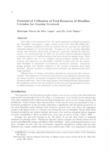Potential of Utilization of Feed Resources of Brazilian Cerrados for Grazing Livestock
Tropical agriculture research series : proceedings of a symposium on tropical agriculture researches
| ISSN | 03889386 |
|---|---|
| NII recode ID (NCID) | AA00870529 |

Full text
tars25-_56-66.pdf1.82 MB
Over 40% of the estimated 130 X 108 cattle population in Brazil is found in the "Cerrados" (savannas), a region which covers more than 200 million hectares. Livestock production levels per animal and per area are low and have remained stagnant for several decades. Forages are low in protein, digestible energy and minerals, particularly phosphorus, especially during the long dry season. It is estimated that by 1990 over 40 million hectares had been planted to pasture and over 12 million hectares had been planted to annual crops. More than 150 million tons of crop residues and by-products, mainly from corn, soybean and sugarcane are potentially available to help solve the dry season feed shortages in integrated crop-livestock production systems. Numerous forage grasses and legumes adapted to the cerrado ecosystem have been released. Recent research on legume-based pastures has demonstrated their large potential.
Effectiveness of cheaper alternative phosphorus sources has been demonstrated. The integration of livestock and annual crop production systems is new but shows promise of potential synergism with important advantages for both livestock and crops. One of the major goals in developing efficient and sustainable production systems for the cerrados to meet the growing demand for food is to reduce pressure on the rainforests of the Amazon basin.
Effectiveness of cheaper alternative phosphorus sources has been demonstrated. The integration of livestock and annual crop production systems is new but shows promise of potential synergism with important advantages for both livestock and crops. One of the major goals in developing efficient and sustainable production systems for the cerrados to meet the growing demand for food is to reduce pressure on the rainforests of the Amazon basin.
| Date of issued | |
|---|---|
| Creator | Henrique Otavio da Silva Lopes Ilto Hosé Nunes |
| Publisher | Japan International Research Center for Agricultural Sciences |
| Volume | 25 |
| spage | 56 |
| epage | 66 |
| Language | eng |
